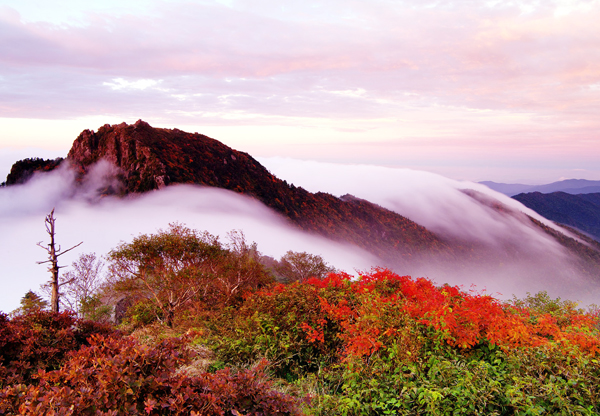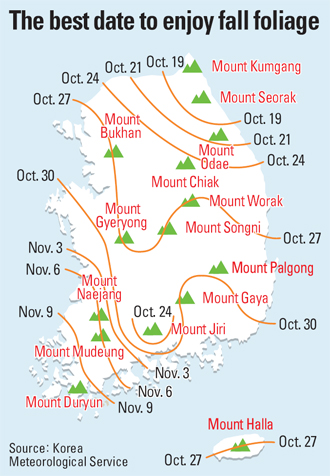Red-letter days: the color of Korean autumn

Chunwang Peak on Mount Jiri, South Gyeongsang, is famous for its breathtaking views of the changing foliage.
Autumn, on the other hand, is much more pleasant, as the changing colors of the leaves and the cool weather create the ideal backdrop to get away and enjoy the countryside.
Here is a list of mountains and places where you can be dazzled with the magic of the changing leaves, which will soon be at their peak, but only for a week or two.
Gangwon Province
Because we had hotter-than-expected weather in September and early October, the peak season for fall foliage has been moved back.
Of all the mountains across the nation, Mount Seorak in Gangwon Province once again was the first place to usher in the changing colors of the season.
The peak of the mountain started turning all sorts of colors late last month, and about 80 percent of the trees on Seorak are now scarlet red and golden.
The colors that started from the peak of Mount Seorak are expected to descend today or tomorrow to Hangye Ridge and Misi Ridge, two of the three most-popular ridges on Seorak, then descend to the small park at the mountain’s entrance by Nov. 3.
Mount Odae is also famous for its colors, with its diversity of trees creating a “five-color” panorama.
Among the many trails available, Seonjae Trail is the most popular. Nicknamed “the forest trail of 1,000 years,” the path opened to the public just a couple of years ago, meaning that the streams and plants that follow it are in excellent condition, as are its new wooden bridges.
The leaves on Mount Odae will be at peak color change around Sunday.
Mount Chiak, which is often called Jeogak, meaning “a mountain with a lot of trees that become red in the fall,” will be at its peak redness next Friday.
If Gangwon is too far from where you live, you can also head to Mount Bukhan, just north of Seoul. It’s probably the most accessible mountain of a decent size where you can enjoy the fall leaves. Visit the mountain today or tomorrow if you plan to do so.
Since the leaves start to change colors from Baegundae Peak, avoid the Baegundae hiking course if you don’t want to bump into an endless parade of strangers also enjoying the fall scenery.

Central Korea
Mount Juwang in Cheongsong, North Gyeongsang, is an ideal destination for those who want to enjoy the beautiful autumn colors set against rugged rocks and cliffs. Rocky cliffs are usually associated with high, difficult-to-climb mountains, but the peak of Mount Juwang is just 834 meters (2,736 feet) above sea level, making it a relatively easy walk. The trees on Mount Juwang will reach their peak colors around Oct. 30.
Another attribute of Mount Juwang is that you can enjoy the beautiful fall leaves as soon as you enter the mountain’s park.
After hiking, trying the signature dish of the Cheongsong region is highly recommended - baeksuk, or chicken stuffed with rice, dates and herbs and boiled in mineral water from the Dalgi Springs - which is known for its piquant taste.
Dak (or “dalg”) is Korean for “chicken,” and the mineral spring got its name from the chicken-like sounds the water make when it bubbles.
Mount Worak in North Chungcheong offers the Haneuljae Trail, another easy course that stretches about 1.5 kilometers (1 mile) around Mireuk-ri, outside of Chungju.
Haneul means “sky” in Korean, and the walking trail got its name from its height, winding 525 meters above sea level - not quite as high as the sky, but close.
Next weekend will be the best time to enjoy fall leaves here.
The south
The first signs of change were noticed high on Mount Jiri, South Gyeongsang, early last month, but the full autumn colors won’t reach the lower part of the mountain until early next month.
Reaching 1,915 meters, getting to the peak of Mount Jiri might be too much for most people, but there are several splendid alternatives for enjoying the leaves, including the Jirisan Dulle-gil, a 300-kilometer walking trail that goes all the way around the base of the mountain. Next Thursday should be the ideal time for enjoying the leaves here.
But be aware: Mount Jiri National Park restricts people from certain courses, depending on safety conditions and the area’s need for a rest from visitors.
Be sure to check what paths are open through the National Park’s Web site at jiri.knps.or.kr.
Except for Mount Jiri, the other mountains in the southern part of the country will reach their autumnal peaks next month.
Mount Naejang in North Jeolla and Mount Palgong in Daegu offer paths so rich with trees that it’s like walking through a tunnel made of colorful leaves.
Another great choice in the south is Mount Mudeung, beside Gwangju, which will allow hikers to go all the way to the very peak of the mountain on Nov. 2. The mountain’s peak is open only four days a year.
For a different view of the fall scenery, try Mount Deogyu in North Jeolla, where a red cable car is available. A round-trip on the cable car costs 12,000 won ($10.40) for adults and 8,000 won for a one-way trip.
Although it is a little trickier because of the fickle weather there, Mount Halla on Jeju Island is also a good place to enjoy autumn leaves.
The Korea Meteorological Service has said hikers should visit Mount Halla during the last week of this month.
Take a train
For those who hate to travel because of potential traffic snarls, the Korean National Railroad is offering several seasonal train packages to many of the country’s major mountains.
Packages include round-trip train tickets, transportation from the train station to the national parks and admission to parks. Prices vary depending on destinations, but they usually start from 60,000 won.
For more information, visit www.korail.com or call 1544-7788 or 02-2084-7786.

From left: Mount Naejang, North Jeolla, is one of Korea’s most famous mountains for the brilliant colors in fall. The Korean Folk Village, located in Yongin, Gyeonggi, is a good place for families to enjoy the fall leaves along with other forms of entertainment. A red cable car is available at Mount Deogyu, North Jeolla, offering a different sort of view on the mountains and the panoramic scenery. [JoongAng Ilbo]
Other places
The best places to enjoy the fall leaves are surely in the mountains, but if you don’t have time and energy to climb a mountain for hours, the Korea JoongAng Daily can recommend some other places near Seoul.
The palaces are some of the most picturesque and quiet places for an autumn trip. Since most of Seoul’s palaces have tall trees that are hundreds of years old, the combination of orange leaves and old buildings is quite pleasing.
The Korean Folk Village in Yongin, Gyeonggi, is another good location. Unlike the palaces, the folk village offers additional fun activities like traditional rides and other forms of entertainment. A popular one is the neolttwigi, the giant seesaw that people use to jump high into the air. With the folk village and food areas, this can be an excellent option for families.
BY SUNG SO-YOUNG [so@joongang.co.kr]










with the Korea JoongAng Daily
To write comments, please log in to one of the accounts.
Standards Board Policy (0/250자)